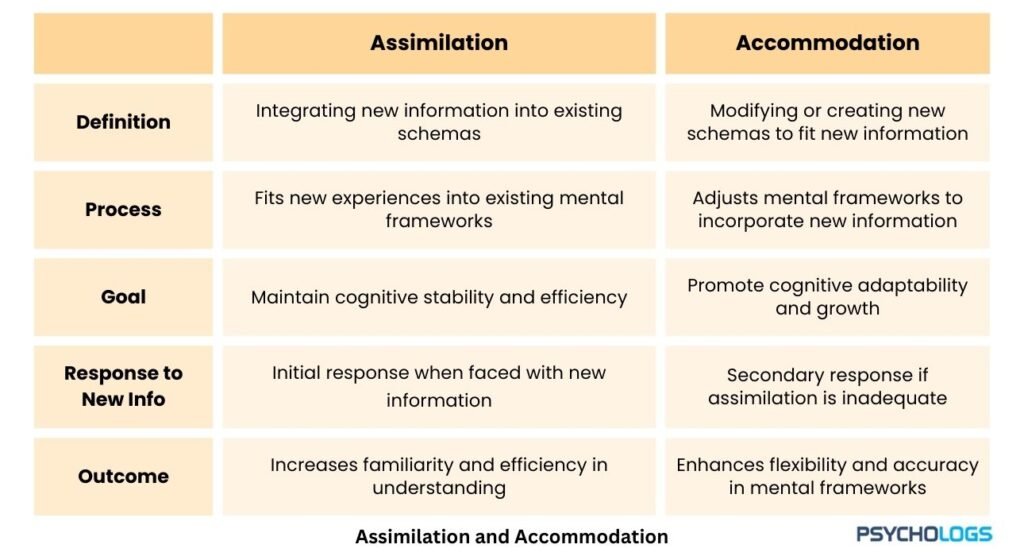Jean Piaget’s theories are foundational in developmental psychology, shaping our understanding of children’s intellectual growth. At the heart of Piaget’s theory lies the idea that children actively construct their knowledge through interaction with their environment. To Jean Piaget, assimilation and accommodation are two important processes in cognitive development. They help children construct and refine mental representations called schemas, which are the building blocks of thinking.
Assimilation
Assimilation refers to “using existing adaptive structures or schemes to integrate or adjust fresh experiential elements.” Or more simply stated, it is our attempts initially to comprehend novel information about what one already knows. As our minds come across something new our brain first tries to respond by fitting it into categories or explanations that we already know. Thus, assimilation is the process of incorporating new information into existing schemas without altering the original structure. It involves fitting new data into categories that are already known.
Example
A child, for instance, begins to understand addition and subtraction in school. Each new mathematical principle is based on the previous one and thus the new information is integrated into what the child already knows about it or when a child sees a new kind of dog he has never seen before but recognizes it as a dog. The child assimilates this novel information into his existing schema of what a dog is.
Accommodation
Accommodation is defined as “the creation of new adaptive structures or schemes to integrate or make sense of formerly conflicting experiential elements.” It takes place where assimilation does not work, hence the existing mental structures cannot account for new information. We may need to form new schemas or change others that we already have, to incorporate the novel experiences or information that we encounter. Thus, it is about altering or modifying existing schemas so that they can accommodate new information that does not fit into the current structure. This process requires the child to adapt their mental representation/schemas to better match the environmental requirements.
Example
Children believe in mythical characters that are part of their culture e.g. Santa Claus. When they learn that these characters do not exist, they adjust their values to accommodate the cultural holiday without believing in these mythological beings, thus accommodation occurs when a child
changes his/her pre-existing schema to fit into the new information. Another example is when a child first mislabel a cat as a dog but then learns to accommodate for the differences between them and makes another category of ‘cats’.
The examples demonstrate how assimilation and accommodation emerge during children’s cognitive development enabling them to construct and refine mental representations of reality to continuously make sense of the world around them.


Associated & Related Terms
Schemas are like mental blueprints that help us make sense of the world. They’re the basic structures we use to organize and understand information. When we encounter new experiences, we first try to fit them into our existing schemas—this is assimilation. However, if the new information doesn’t quite fit, we adjust our schemas through accommodation. This might mean tweaking our existing schemas or creating new ones altogether. These updated schemas then become the foundation for how we approach future experiences, continuing the cycle of learning and adaptation.
Equilibration
The process of equilibration is the state of assimilation and accommodation being balanced. It ensures that children transition between different stages of thinking, adapting their mental structures to incorporate new information while also maintaining a sense of stability and consistency in their cognitive development. The equilibrium is important for children as it helps them build and perfect their schemas which foster an increase in intelligence and cognitive development. Our schemas are in a state of equilibrium when our experiences are explained by them. Cognitive disequilibrium is created if there are new experiences that cannot fit into our existing schemas. We achieve balance by either assimilation or accommodation.
Cognitive development
The continuous cycle of assimilation and accommodation leads to the development of more complex and accurate mental frameworks over time. This process is fundamental to cognitive growth and learning. Assimilation contributes to stability and efficiency in thinking by integrating new information into existing schemas. In contrast, accommodation fosters adaptability and growth by modifying or creating new schemas to better fit novel experiences. Together, these processes enable cognitive flexibility, allowing individuals to navigate and understand the world more effectively.
Different people have various inclinations for how they balance these two processes which can affect their learning styles and problem-solving approaches. As individuals develop, their ability to engage in both assimilation and accommodation becomes more sophisticated. Younger children depend more on assimilation, whereas older children and adults learn better than them when it comes to accommodating if necessary.
Research findings
In the journal of the Society for Research in Child Development a paper by Jack Block presents a nuanced view of how these processes work together. It suggests that assimilation acts as our primary cognitive response when encountering new information. Initially, we attempt to fit this new information into our existing mental frameworks. Only if assimilation fails to adequately explain or integrate the new information do we then turn to accommodation, where we adjust or create new schemas to better understand and adapt to the new experiences. This sequential approach highlights assimilation as the first line of cognitive processing, with accommodation serving as a secondary strategy when needed.
This sequential view differs somewhat from Piaget’s original conception, which sometimes portrayed assimilation and accommodation as simultaneous processes. This new interpretation of Piaget’s theory offers valuable insights for educators, psychologists, and anyone interested in cognitive development. It emphasizes the importance of providing experiences that challenge existing schemas, encouraging the process of accommodation. At the same time, it highlights the value of building on existing knowledge through assimilation that then together contributes to cognitive growth and development.
Piaget’s Stages of Development
In the early stages, assimilation might be more dominant as children try to understand the world through their limited existing schemas. As cognitive abilities develop, individuals become more skilled at accommodation, allowing for more flexible and abstract thinking. Understanding that assimilation and accommodation occur across all stages helps to emphasize the continuous nature of cognitive development in Piaget’s theory. These processes are the driving forces behind the progression from one stage to the next and the ongoing refinement of cognitive abilities within each stage.
As research continues to build upon Piaget’s foundational work, we gain deeper insights into the sequential nature of these processes and their role across different developmental stages. The knowledge of the concept of assimilation and accommodation is vital to teachers, parents and psychologists who seek to facilitate effective learning environments and enhance children’s cognitive development. By recognizing the balance between integrating new information into existing frameworks and adapting those frameworks, when necessary, we can better appreciate the complex and dynamic nature of cognitive growth from childhood through adulthood as it is evident that cognitive growth starts early in life and continues throughout one’s entire life and individuals build upon schemas, they already have to develop more complex ones.
FAQs
Q: How does the process of assimilation differ from accommodation in Piaget’s theory?
A: Assimilation is the procedure through which new information is taken into account and included in mental schemas without altering the schema itself. Contrastingly, accommodation consists of either modifying or making new schemas so that this could be fit by information that doesn’t correspond to existing frameworks. While assimilation maintains cognitive stability; accommodation promotes adaptability and growth.
Q: How do assimilation and accommodation contribute to cognitive development?
A: Assimilation and accommodation complement each other in a mutually supportive sequence, refining and expanding a child’s knowledge about the world. This progression then leads to the creation of more complex and correct schemas over time. Assimilation allows for the efficient processing of familiar information while accommodation enables adaptation to new experiences thus promoting cognitive flexibility and growth.
Q: At what stage of development are children more likely to use assimilation versus accommodation?
A: Younger children heavily rely on assimilation as they attempt to make sense of the world using their limited existing schemas. Accommodation becomes stronger with cognitive development facilitating flexible thinking that is abstract. Nonetheless, both processes occur throughout all.
Q: How does an understanding of assimilation and accommodation help educators and parents?
A: Understanding these concepts can be beneficial to both parents and teachers because it’ll enable them to create more effective learning environments. In this regard, adults can provide appropriate challenges and support by recognizing when children are either assimilating new information or need to accommodate their existing schemas. Knowledge of this sort may influence how we teach, what we include in our curricula, balance the familiar with the unfamiliar to encourage cognitive growth.
References +
- Simply Psychology. (2024, January 24). Accommodation and assimilation in Psychology. https://www.simplypsychology.org/what-is-accommodation-and-assimilation.html
- Piaget & Assimilation | Definition & Child Development – Lesson | Study.com. (n.d.). study.com. https://study.com/academy/lesson/assimilation-and-piaget-definition-theory-process.html
- Heick, T. (2023, October 17). The Assimilation vs Accommodation Of Knowledge. TeachThought. https://www.teachthought.com/learning/assimilation-vs-accommodation-of-knowledge/
- [Solved] The process of striking a balance between accommodation and. (2024, April 8). Testbook. https://testbook.com/question-answer/the-process-of-striking-a-balance-between-accommod–5e43f7dcf60d5d5f6ee4b4ea
- Simply Psychology. (2024, January 24). Piaget’s Stages: 4 Stages of Cognitive Development & Theory. https://www.simplypsychology.org/piaget.html
- Piaget Stages of development. (2024, February 16). WebMD. https://www.webmd.com/children/piaget-stages-of-development
- BetterHelp Editorial Team. (2024, April 26). What is assimilation in psychology? | BetterHelp. https://www.betterhelp.com/advice/psychologists/what-is-assimilation-psychology-explains-why-its-important/
- Main, P. (2023, April 28). Assimilation vs accommodation. Structural Learning. https://www.structural-learning.com/post/assimilation-vs-accommodation
- Cornell, D. (2024, May 26). 15 Examples of Assimilation in Psychology (2024). Helpful Professor. https://helpfulprofessor.com/examples-of-assimilation-in-psychology/
- Block, J. (1982). Assimilation, accommodation, and the dynamics of personality development. Child Development, 53(2), 281–295. https://doi.org/10.2307/1128971https://www.jstor.org/stable/1128971







Leave feedback about this